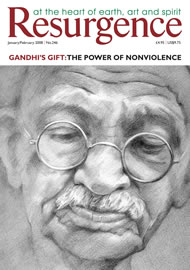AT THE HEART of this important book is a persuasive, illuminating metaphor of sickness and healing. Paul Hawken, whose influential book The Ecology of Commerce set out the debate between the rights of the environment and the rights of business, has been travelling and meeting environmental and social justice groups worldwide for the past fifteen years. From this perspective he is able to identify what looks like the biggest social movement in the history of humankind: probably a million or more small grassroots groups working to “remake the world”.
The sickness he unflinchingly describes lies not only in environmental destruction – there is an unbearably painful story of the killing, in 1852, of a 300-foot, 2,500-year-old sequoia in California, felled so it could be exhibited as a sideshow on the East Coast – but also in the loss of indigenous cultures around the world who unfortunately for the last 500 years have found themselves in the way of the greed and brutality of less civilised societies bent on resource extraction.
We will never fully appreciate the depth and breadth of the New World cultures which imploded after the conquest of the Americas: an estimated 98% of the population died of “disease, violence and heartbreak” within 200 years. Hawken is uncompromising in his opposition to today’s multinationals who “legally or illegally, impose their will on indigenous cultures” and gives a depressingly long list of their names. But, in keeping with the theme of the book, he also gives us hope: thirty-eight organisations exist to defend the Amazon region alone, all networked with and assisted by Amazon Watch in San Francisco.
In tracing the roots of this worldwide phenomenon, Hawken takes us via Emerson and Thoreau to the birth of the conservation movement in the United States. He shows how Rachel Carson’s Silent Spring, which warned of the dangers of DDT, established the basic dynamic between environmentalists and industry, provoking a furious and misogynistic backlash from chemical companies who called Carson “more poisonous than the pesticides she condemned”. Her name and influence live on in many ways, not least the e-bulletin Rachel’s Democracy and Health News sent out by Peter and Tim Montague in New Jersey, who, tireless and unpaid, provide inspiring articles and reviews to their subscribers every week.
In an overview of the origins of the civil rights movement, Thoreau’s influence on Gandhi, and Gandhi’s on Martin Luther King are explored, with a fascinating side story about the background and education of Rosa Parks and how in 1955 she came to take the action that sparked off the Montgomery bus boycott and the civil rights campaign. More than once in this book, Hawken takes a story we think we know and illuminates it in a truer light: Martin Luther King’s first civil rights speech on the first night of the boycott, given here in its entirety, is simply astounding.
One persistent theme of Blessed Unrest is the principle that social justice and environmental justice cannot be separated: what harms our environment harms us, as Carson so eloquently showed. We are losing biodiversity in human cultures and natural environments; what this means is a tremendous loss of resilience. “If overwhelming the ecological integrity of watersheds, forests or seas is biological suicide, it is not a big step to imagine that overwhelming indigenous cultures is equally shortsighted.” We need to start seeing indigenous cultures with their intimate understanding of how to live well in a place as “an image of a future by which we can escape our present”, and re-civilise ourselves, with the understanding that “living within the biological constraints of the Earth may be the most civilised activity a person can pursue.”
SO WHERE ARE the healing, the restoration, the hope? We are familiar with the idea of the Earth as a living, self-regulating organism. What if we extend that concept to humankind? Can we see the grassroots activist groups arising all over the world as “a collective movement that would protect, repair and restore that organism’s capacity to endure when threatened”? Just as in the human immune system, the movement’s function depends on the “quality of its connectedness” – it is this connectivity that allows small organisations to be task-specific and use resources precisely and frugally. The multiplicity of concerns that some have reproached the movement for actually then becomes its strength and the smallness of its constituent groups becomes a virtue.
It is impossible in this short review to do more than hint at the subtlety and inventiveness of this book, with its profound insights and heart-stopping images. One third of the book is appendix: over 100 pages long, it sets out not the names of all the groups known to Hawken and his team, but a complete taxonomy of their concerns – from Agricultural Policy to Workers’ Rights. It represents, says Hawken, the “most complete listing of issues that need to be addressed to achieve a just and sustainable world. It is a curriculum and a course catalogue for a university that should but does not exist.” Will any educators take up this momentous challenge?
The database that has been set up to link and network all these groups is at www.wiserearth.org. If you belong to a grassroots group working for a sustainable future, you can add your group, offer resources freely to others, find support and encouragement. You can become an active part of the immune system that the Earth has produced to protect itself; of a broad non-ideological movement creating a new narrative. We may dare to hope that, leaderless yet with a shared vision, small yet powerfully connected, diffuse yet globally pervasive, it will prevail.






